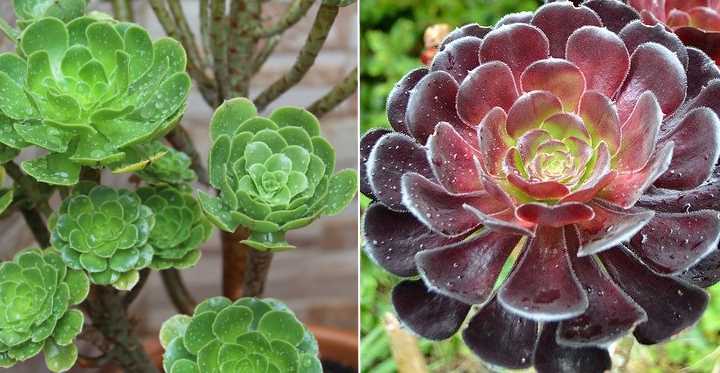Tree Aeonium (also known as Aeonium arboreum) is an evergreen succulent plant with thick woody stems, large rosettes, and showy yellow flowers. Irish rose, housetree leek, desert pinwheel rose, and tree houseleek are some of the other names for the species Aeonium arboreum. These huge subtropical trees flourish as houseplants in pots or as outdoor plants in warm, bright gardens.
Growing Aeonium arboreum, also known as the tree aeonium, is covered in this article. You’ll discover how to overcome a variety of aeonium care difficulties when cultivating this shrubby succulent at the conclusion of the article.
Aeonium Arboreum Care — Overview
Grow the succulent in porous sandy soil with excellent drainage to care for Aeonium arboreum. Without becoming waterlogged, water the tree aeonium. Full sun and a temperature range of 40°F to 100°F (4°C to 38°C) are ideal for aeoniums. In the spring and autumn, fertilize.
What is Aeonium Arboreum (Tree Aeonium)?
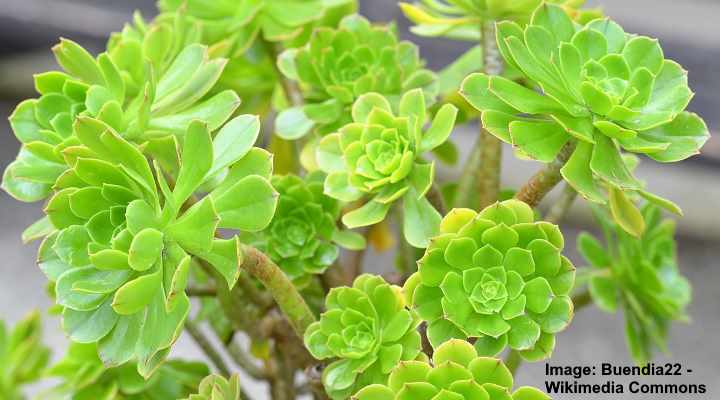
There are 35 cultivars of Aeonium arboreum succulents, which grow as multi-stemmed shrubs. The Canary Islands are home to the majority of Aeonium species. They thrive in warm, dry summers and mild winters. Tree aeoniums may grow to be up to 6.5 feet (2 meters) tall as multi-stemmed shrubs.
Tree aeoniums’ conical flower clusters and huge rosettes made of succulent leaves are two identifying characteristics. Succulent leaves appear to be a spoon or spatula when viewed from the top. The rosette-shaped leaves develop in a spiral formation. Light to dark green leaves are common. When tree aeoniums grow in full sun, red colors may appear on the leaf margins.
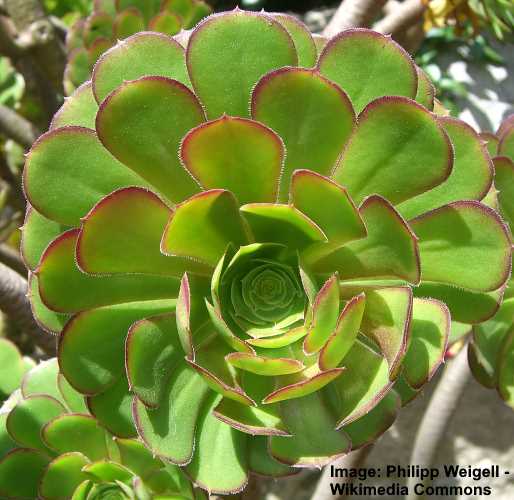
Tree aeonium succulents (Aeonium arboreum) grow fast in full sun and have crimson borders. In subtropical regions, unlike most other succulents, aeonium plants grow best during the mild winter, spring, and fall months. The succulent aeonium shrub goes dormant during hot, dry summers and requires minimal care. USDA zones 9 through 11 are ideal for Aeonium arboreum.
Most types of succulents are not similar to Aeonium arboreum. Despite having thick woody stems and meaty leaves, Aeonium arboreum succulents have a shallower root system than other succulents. As a result, tree aeonium needs more attention than other succulent plants.
You must, however, keep the soil from becoming soggy all of the time, as with most succulents. Irish rose plants resemble echeverias in many ways.
Aeonium Arboreum Flowers

Aeonium arboreum tree flowers have big pyramid-shaped flower clusters (inflorescence) that sit on the tips of long stalks. Between 5 and 20 inches (12–50 cm) long, these flowering stems flourish. Each fuzzy conical inflorescence can grow to be up to 25 cm tall. Each flower head is made up of small yellow star-shaped flowers.
Varieties of Aeonium Arboreum
Purple, dark purple to black, pink, light green, and variegated colors are among the spectacular colorful foliage of several tree aeonium cultivars. Daisy-like foliage resembling huge, saucer blooms or roses may be seen on several of the Aeonium arboreum cultivars. Some of the most magnificent tree aeonium varieties may be found here:
Aeonium arboreum ‘Atropurpureum’—Massive dark-purple, maroon glossy rosette leaves characterize the aeonium species known as the “black tree.” Between 3 and 5 feet (1.5 to 1.5 meters) tall, the dark purple houseleek tree succulent grows.

Aeonium arboreum ‘Zwartkop’—The foliage of this aeonium tree is similar to that of the Atropurpureum aeonium, although it is darker. The elongated spatula leaves of this succulent are deep purple, almost black. This Aeonium variety, sometimes known as the Black Rose, grows up to 3 feet (1 meter) tall.
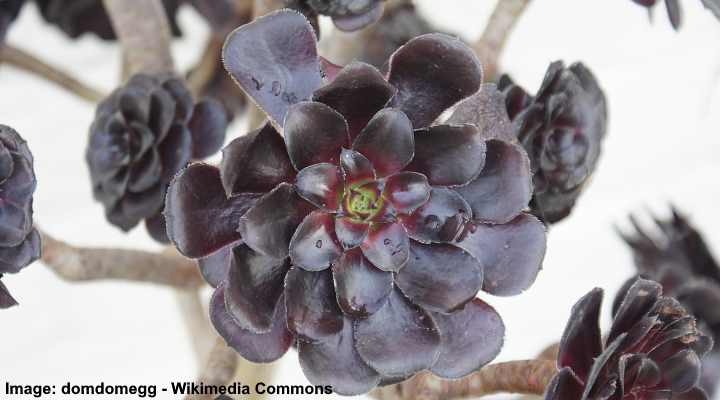
Aeonium arboreum ‘Luteovariegatum’—A variegated aeonium succulent with light green, brilliant yellow, and streaks of pink hues is the tree houseleek cultivar. At the end of 18-inch (45-cm) stalks, the pretty rosettes thrive.
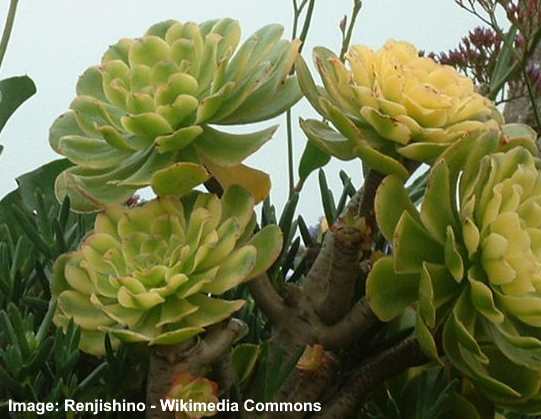
Aeonium arboreum ‘Velour’—The fleshy, spoon-like leaves of this magnificent aeonium grow in a wide rosette. The huge round rosette has a brilliant green center and the lustrous succulent leaves are dark burgundy to purple in hue.
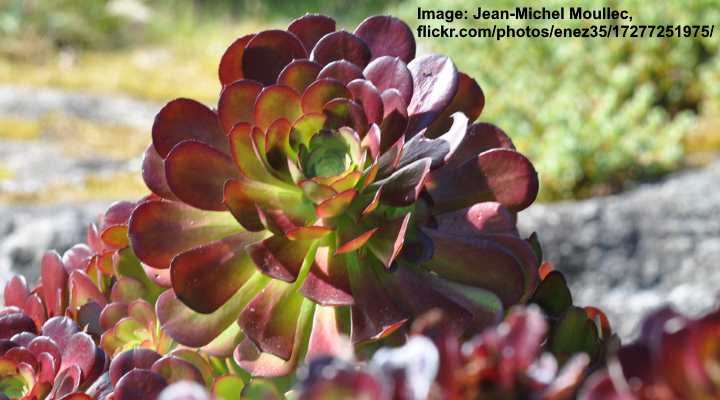
Aeonium arboreum ‘Velour’
How to Care for Aeonium Arboreum (Tree Aeonium)
If you live in the right climate, tree aeoniums are simple to care for outdoors. Keep the ground moist without being soggy, and shelter the housetree leek from direct hot sunlight for everything you need to do. Frost protection is required for low-maintenance rose-like plants. In your sunny yard, let’s take a closer look at how to cultivate tree aeoniums.
Aeonium Arboreum Light Requirements
For best results, the aeonium tree should be grown in full sun or partial shade. In order to thrive in backyards, aeoniums require six hours of sunlight each day. The bright rosette leaves stay vibrant and healthy even in the summer, when growth is dormant.
It’s important to remember that too much intense sunlight can scorch the leaves of an Aeonium arboreum while growing it in your yard. In partial shade at midday, the houseleek tree thrives best.
Natural sunlight is also required for growing potted tree aeoniums indoors. Aeonium arboreum thrives in bright light and will grow well if it is shielded from intense sunlight that comes directly through the windows. Low-light loving plants aren’t aeoniums. The woody stalks get leggy and the rosette foliage gets sparse if there isn’t enough light.
The Best Soil for Growing Irish Rose (Aeonium Arboreum)

The Aeonium arboreum succulent thrives in rich, porous well-draining soil. Amend the soil with sand and limestone chips to prepare it for planting. Water drains freely from the tree aeonium because this soil mix aerates the planting site. Keep the ground moist by mulching around the plant stems.
Succulents like tree aeoniums thrive in pots, whether indoors or out. Mix two parts perlite or pumice with one part peat moss to create the perfect succulent soil. This lightweight potting soil prevents soggy potting soil by allowing water to drain freely.
Instead, you might combine one part perlite, one part coarse horticultural sand, and two parts regular potting soil to make a succulent potting mix. The potting soil offers nutrients while retaining some moisture, while the light inorganic perlite improves drainage.
How to Water Tree Aeonium Succulents
Only when the top layer of soil dries out do water aeonium arboreum plants grow. Aeoniums may need to be watered every seven days during warm weather. You may only need to water the succulents once a month in the summer, during the dormant phase.
Avoid watering tree aeoniums on a regular basis for the best results. Before soaking the ground, always check the soil for dryness. Fall, with mild winters, and then spring are Aeonium’s active growth periods. When the plant stops growing due to hot, dry weather conditions. As a result, to keep your plant adequately watered while not drowning it, you’ll want to consider this.
Only water aeonium shrubs in pots when the top 0.5 inch (1 cm) of soil is dry; otherwise, they won’t thrive. Add enough water to keep the roots hydrated. When the soil has dried somewhat more, it’s time to water your plant again. Overwatering aeoniums causes mushy, yellow leaves and root rot, so it’s important to remember that.
The succulent leaves will wilt and possibly droop if the soil or ground gets too dry. Aeonium plants are dormant during the summer, unlike most other plants. Allow half of the potting mix to dry between waterings throughout this period.
Top care tip for tree aeoniums: Tree aeoniums, despite being succulents, need watering more often than most succulent plants.
The Best Temperature for Growing Tree Aeonium
Between 40°F and 100°F (4°C and 38°C), the tree aeonium thrives. Aeoniums prefer a Mediterranean climate. This implies warm, dry winters with occasional rain and freezing temperatures. When the nighttime temperatures drop no lower than 50°F (10°C), tree aeoniums thrive best in the winter. If you have hot, dry desert-like summers or frigid cold winters with snow, growing aeoniums outdoors is difficult.
Do Aeonium Arboreum Plants Need Fertilizer?
Aeoniums are light feeders that don’t need additional nourishment. Without additional nutrients, succulent plants growing in the ground thrive. Root burn and damage to the plant’s glossy rosette foliage may occur if aeonium soil is overly fertilized. To feed tree aeoniums growing in pots, you might use a natural, organic houseplant fertilizer.
To encourage robust development, apply some worm compost in the early spring. Most aeonium enthusiasts, on the other hand, claim that they can grow healthy potted plants without fertilizing them.
Aeonium Arboreum Pruning
To reduce dead leaves, eliminate leggy stems, and avoid excessively thick rosettes from breaking the branches, aeoniums only need trimming. Pruning is not required for this plant to maintain its form. Pruning is primarily used to enhance the aeonium’s look in most situations.
Tree Aeonium Propagation
Rooting stem cuttings is the finest method to grow Aeonium arboreum. Cut off a rosette from an aeonium and leave about 1 to 2 inches (2.5 to 5 cm) of stem on the head in order to grow a new tree. Sprinkle a combination of peat moss and perlite over the stem. Put the cutting in a bright, warm environment and keep the soil moist. Aeonium cuttings takeroot between two and three weeks.
You can move the tree aeonium to a bigger container containing an suitable potting mixture for succulents when roots emerge. Baby rosettes that emerge from rosette heads are a common sight. You can propagate these offsets by putting them in a rooting mix that is separate from the plant.
Care tip for propagating tree aeoniums: Make sure the cutting is kept between 64°F and 75°F (18°C and 24°C) in a bright environment.
Repotting Irish Rose Plants
Repot Aeonium arboreum every two years in the spring to encourage healthy growth. Remove the woody succulent from its original container gently. Remove the roots from the pot, shaking off any excess soil. Then replant the tree aeonium at the same height as it was growing before in a new, bigger pot filled with an appropriate potting mix.
Take care of the stems while repotting tree aeoniums. The branches of large, heavy rosette foliage are particularly prone to breaking. To prevent aeonium plants from falling over, you may have to stake them larger.
Pests Affecting Aeonium Arboreum Growth
Common houseplant pests aren’t usually a problem for aeonium tree species. Spider mites, mealybugs, and aphids are the most common bugs that cause problems. To remove insects and mites from the aeonium rosette leaves, apply a homemade neem oil spray.
For the greatest outcome, apply neem spray every seven days. Mix 2 teaspoons neem oil with 1 teaspoon liquid Castile soap in 1 quart (1 l) of warm water to create a neem oil solution.
In a spray bottle, thoroughly combine the ingredients. Mealybugs, aphids, and spider mites can be removed by spraying the neem solution on the succulent leaves. It’s crucial to identify signs of houseplant infestations in order to safeguard your lovely aeoniums. Here are a few things to watch for:
- Spider mites on aeoniums—By examining the silky webbing between the fleshy succulent leaves on the rosette head, you can identify spider mites. Red dots between leaves are an indication of some spider mites.
- Mealybugs on aeoniums—The white fuzzy substance that aeonium leaves and stems leave behind can be used to identify mealybugs.
- Aphids on tree aeoniums—Outdoor tree aeoniums are more likely to be infested with aphids. Hosing aphids off the plant with a strong stream of water is the best way to get rid of them.
Diseases Affecting Aeonium Arboreum Growth
If the plant sits in waterlogged ground, tree aeoniums are susceptible to root rot, as are all succulent species. Water the plant only when the soil is partially dry to prevent root rot. You’ll have to repot the plant in fresh soil if the roots are damaged due to soggy soil and fungal infections. Sadly, the plant may be beyond redemption if substantial root damage has occurred.
Are Aeonium Arboreum Succulents Toxic?
Cats, dogs, and other household pets are not known to be poisonous from tree aeonium leaves or stems.
FAQs About Aeonium Arboreum Care
In warm regions, tree aeoniums are typically easy-care plants that thrive. However, Aeonium arboreum care may be impacted by certain factors. For growing Irish rose succulents outdoors, here are a few helpful hints.
Why do the aeonium succulent leaves turn yellow and droop?
As they age, tree aeonium leaves turn yellow and sag. As a result, on aeonium succulents, limp, yellow leaves are usually harmless. The few yellow leaves that appear can be removed. Watering problems may cause yellow leaves on aeoniums. You may have to reduce watering if you notice that yellow aeonium leaves are swollen and mushy. Your plant requires more water if the leaves are shriveled and yellow, and the soil is dry.
When do tree aeoniums turn darker colors?
The varieties of tree aeoniums known as the Zwartkop (Black Rose) and Atropurpureum (Black Houseleek Tree) require considerable sunlight to create dark leaves. Make sure that the succulents get at least 6 hours of sunlight every day. But, protect them from extremely intense, direct heat rays.
How do you look after a tree aeonium in the winter?
During the winter, maintaining the earth damp but not waterlogged is the best way to care for tree aeoniums. To maintain some moisture at the roots, water the Irish Rose or Black Rose only occasionally. When the temperature drops below 50°F (10°C), bring the potted aeonium inside if you live in a temperate climate.
Why are aerial roots growing from the tree aeonium stem?
Aeonium species produce aerial roots as a natural occurrence. When the aeonium requires more water, aerial roots are common. Nonetheless, unless you experience other indications of a nutrient deficiency, such as yellowing foliage or drooping development, you shouldn’t be too concerned.
What to do with aeonium after flowering?
Monocarpic trees, like aeoniums, perish once they bloom. After the bloom stalk has finished blooming, cut it to prevent it from dying. After a period of time, you’ll see that a little group of plants has sprouted from the severed stem. Multi-stemmed aeonium bushes, on the other hand, don’t bloom from every branch. As a result, for many years, your shrubby succulent should thrive.
